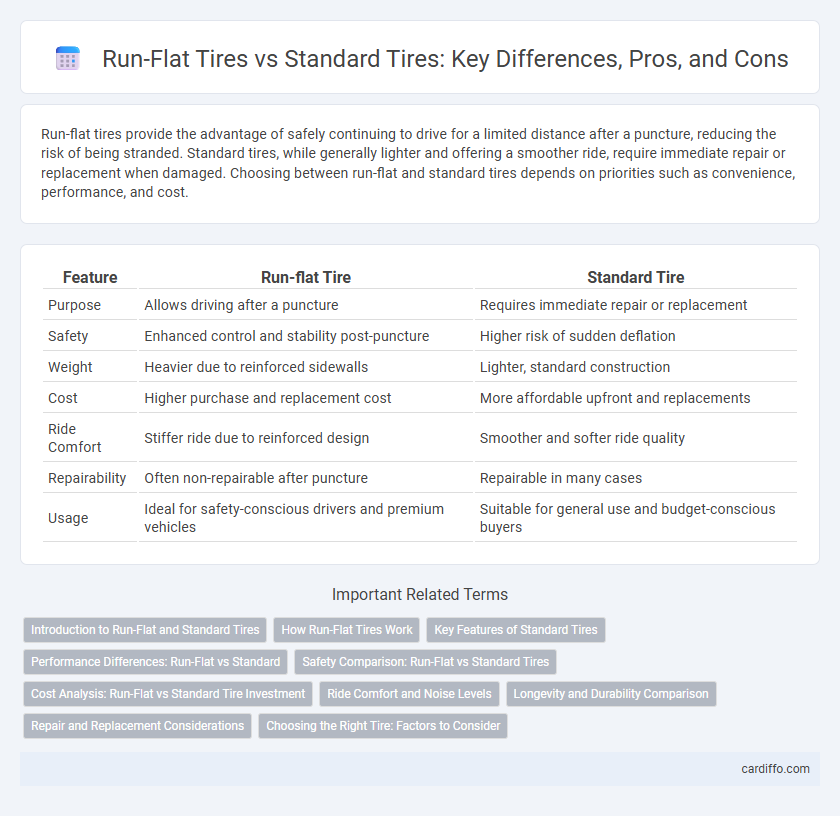Run-flat tires provide the advantage of safely continuing to drive for a limited distance after a puncture, reducing the risk of being stranded. Standard tires, while generally lighter and offering a smoother ride, require immediate repair or replacement when damaged. Choosing between run-flat and standard tires depends on priorities such as convenience, performance, and cost.
Table of Comparison
| Feature | Run-flat Tire | Standard Tire |
|---|---|---|
| Purpose | Allows driving after a puncture | Requires immediate repair or replacement |
| Safety | Enhanced control and stability post-puncture | Higher risk of sudden deflation |
| Weight | Heavier due to reinforced sidewalls | Lighter, standard construction |
| Cost | Higher purchase and replacement cost | More affordable upfront and replacements |
| Ride Comfort | Stiffer ride due to reinforced design | Smoother and softer ride quality |
| Repairability | Often non-repairable after puncture | Repairable in many cases |
| Usage | Ideal for safety-conscious drivers and premium vehicles | Suitable for general use and budget-conscious buyers |
Introduction to Run-Flat and Standard Tires
Run-flat tires are engineered with reinforced sidewalls that support the vehicle's weight even after air pressure loss, allowing temporary travel up to 50 miles at reduced speeds. Standard tires rely on air pressure for structural integrity and require immediate repair or replacement following a puncture to prevent tire failure. Choosing between run-flat and standard tires impacts vehicle safety, convenience, and repair options during unforeseen tire damage.
How Run-Flat Tires Work
Run-flat tires feature reinforced sidewalls that support the vehicle's weight even after air pressure is lost, allowing safe driving for a limited distance at reduced speeds. These tires maintain structural integrity without immediate air pressure, enabling drivers to reach a repair shop without changing the tire on the roadside. The technology reduces the risk of accidents caused by sudden blowouts and enhances convenience during tire emergencies.
Key Features of Standard Tires
Standard tires offer superior ride comfort due to their flexible sidewalls, allowing better absorption of road irregularities. These tires generally provide lower rolling resistance, enhancing fuel efficiency compared to run-flat alternatives. Their availability across a wide range of sizes and tread patterns ensures compatibility with diverse vehicle types and driving conditions.
Performance Differences: Run-Flat vs Standard
Run-flat tires offer enhanced safety by maintaining pressure for up to 50 miles at reduced speeds after a puncture, unlike standard tires that require immediate repair. Their reinforced sidewalls provide stability during air loss but often result in a firmer ride and slightly higher rolling resistance, affecting fuel efficiency. Standard tires generally deliver better comfort and handling under normal conditions, but they lack the fail-safe capability of run-flat tires in critical situations.
Safety Comparison: Run-Flat vs Standard Tires
Run-flat tires provide enhanced safety by allowing drivers to maintain control and continue driving at reduced speeds for up to 50 miles after a puncture, reducing the risk of accidents caused by sudden tire failure. Standard tires require immediate replacement or repair after a puncture, often leaving drivers stranded and vulnerable on the roadside. The reinforced sidewalls of run-flat tires minimize the chances of blowouts, offering superior protection particularly during high-speed driving or emergency maneuvers compared to standard tire construction.
Cost Analysis: Run-Flat vs Standard Tire Investment
Run-flat tires typically cost 20-40% more upfront than standard tires, impacting initial vehicle maintenance budgets. Standard tires require frequent replacements due to faster wear, potentially increasing long-term expenses compared to the extended durability of run-flats. Factoring in the cost of roadside assistance and tire repair services, run-flat tires can offer savings by preventing costly emergency tire changes.
Ride Comfort and Noise Levels
Run-flat tires typically offer reduced ride comfort due to their reinforced sidewalls, which absorb less road vibration compared to standard tires. Standard tires generally provide a smoother and quieter ride, as their more flexible construction better dampens road noise and uneven surfaces. Noise levels in run-flat tires can be higher because the stiffer sidewalls transmit more sound and vibration into the cabin.
Longevity and Durability Comparison
Run-flat tires typically feature reinforced sidewalls that enhance durability and allow continued driving after a puncture, offering improved longevity compared to standard tires. Standard tires rely on immediate repair or replacement after a puncture, which can reduce their overall lifespan due to increased risk of tire damage. Overall, run-flat tires provide extended usability and robustness, especially in emergency situations, while standard tires may require more frequent maintenance to maintain longevity.
Repair and Replacement Considerations
Run-flat tires often allow drivers to continue driving for up to 50 miles at reduced speeds after a puncture, reducing immediate repair urgency and potentially avoiding roadside tire changes. Standard tires typically require prompt repair or replacement following a puncture to prevent further damage or unsafe driving conditions. Repair costs for run-flat tires can be higher due to their reinforced sidewalls and specialized construction, while replacement options may be limited compared to standard tires, influencing overall maintenance decisions.
Choosing the Right Tire: Factors to Consider
Choosing the right tire involves evaluating factors such as durability, safety, and performance under different conditions. Run-flat tires offer the advantage of maintaining mobility after a puncture, enabling drivers to continue driving for limited distances at reduced speeds without immediate replacement. Standard tires generally provide a smoother ride and are often more cost-effective, but may require immediate repair or replacement after damage.
Run-flat vs Standard Infographic

 cardiffo.com
cardiffo.com